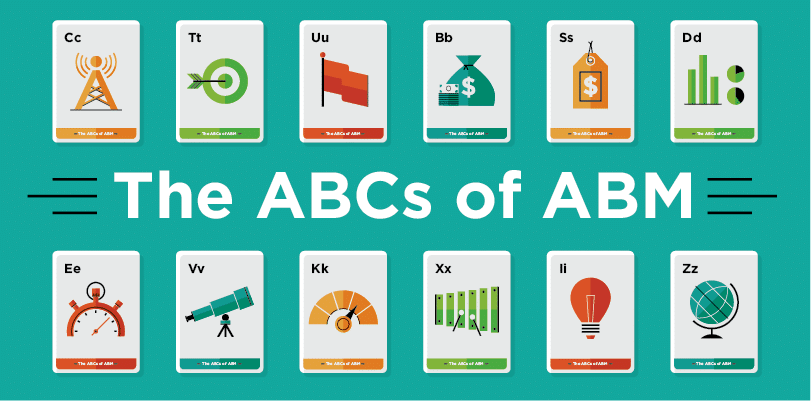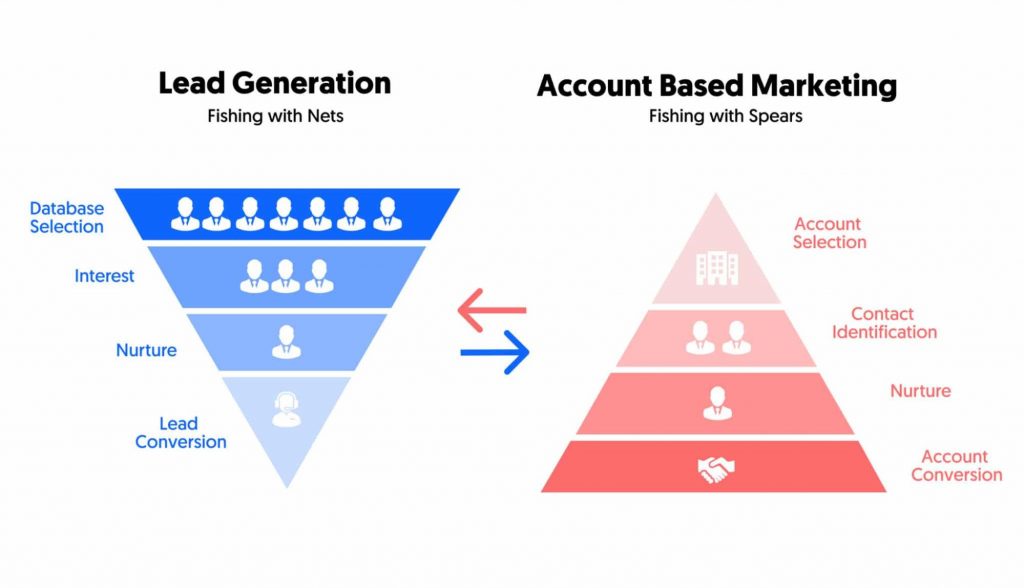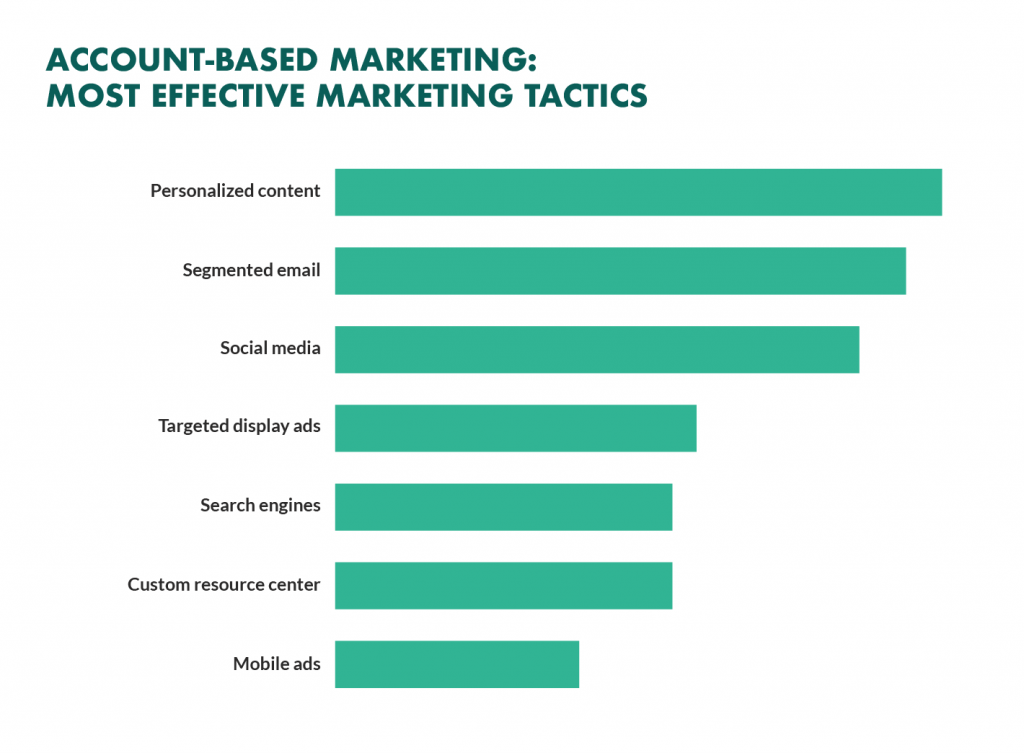Time means money, and this is a principle that can be easily applied to your marketing strategies as well.
Add to that the principle of efficiency and you might just be on to something. Top that with a highly personalized campaign, destined to attract specific accounts, and you might’ve just painted the entire picture of account-based marketing.
What is account-based marketing?
The simplest explanation for account-based marketing is that it’s a model in which marketers concentrate on engaging a very specific set of accounts that are most likely to make a purchase.
Thus, a higher revenue can be obtained in a shorter period of time, through personalization, making this strategy efficient as well.
A real-life example could be that of an old-school salesperson, knocking on your door, presenting you a product or a service, and then closing the deal.
The example described above is a one-to-one approach, in which the salesperson took charge of putting together a customized plan for a valuable prospect, in order to build a stronger sense of engagement.
Opposite of the one-to-one approach is the one-to-many approach, in which the customized plan is scaled in such a way that it can be applied to a larger number of prospects.
Are you curious to know more?
There are a few tactics and strategies that account-based marketing makes use of, though. This article will present you with a few of these strategies and tactics that you can implement in order to drive the best results in your campaign.
So, let’s find out how to put your selling efforts into prospects that will most likely be interested in what you have to offer.
Account-Based Marketing Strategies
Strategy is an important and influential pillar of account-based marketing. Without a put-together strategy, there is a risk of falling out of place in terms of tactics, which is the opposite of what we want.

1. Establishing the Objectives
You’ve already established the fact that you’re going for an account-based marketing campaign, so the first big step has been taken.
Now, you need to establish the objectives that you are trying to run your campaign on. You need those in order to establish the industry you’d like to target, and the Ideal Customer Profile (ICP), as well as the targeted accounts.
For example, if your objective is to generate engagement from your targeted account, you need to concentrate your account-based marketing campaign on awareness.
Your objectives can also aim at increasing the average revenue, converting a specific number of trials, or delivering a specific number of proposals.
Either way, the objectives you establish dictate the flow of your account-based marketing campaign.

2. Targeting your Accounts
One of the main aspects of account-based marketing is that it concentrates on an individual as much as it concentrates on an organization comprising individuals. This changes the rules of the game up to an extent.
Organizations tend to have specific attributes, which can give you the first idea in terms of what accounts you have to target.
Whether you already have a few accounts added to your folder, or you’re in the process of doing that, those attributes can tell you what direction to head to.
Based on similarities, you can also go the extra mile and target other businesses.
3. Transitioning From Targeted Account to Key Player
Organizations have key players that are involved in the decision-making process, and learning who these people are and the flow of this process can be a useful strategy.
Gathering a few of these pieces of information can help you figure out your next steps in terms of interaction, as well as approach.
Social media is a good place to start — platforms like LinkedIn can give you a good insight into the organization, as well as these key players.
Depending on the business, Twitter might also be a good choice. And this brings us to our next strategy.
4. Choosing the Right Marketing Channels
The accounts and key players you are targeting usually have a preference for certain platforms.
This can determine the type of content you have to create and it can also dictate your approach, from the perspective of reaching out to a key player on a specific platform or advertising specific platforms on websites that they are interested in.
It is also safe to say that the right marketing channels can determine customers to start engaging and in the end, go all the way to making a purchase.
Account-Based Marketing Tactics
1. Direct Mail
Your first hunch might’ve been that we’re talking about some form of emails here. But that is not the case, as we are referring to direct mail here, or much better said physical mail.
Even though this might sound like a stretch, direct mail is a tactic that works, no matter the year. And this is mostly because a package cannot be left in the “Unread” section of your inbox, or worse — deleted.
Direct mail literally gets opened and it is also quite personalized. Firstly, you stand out from the crowd by sending out a package destined either for the person you have been reaching out to or the entire organization.
Secondly, you can create a great brand experience or send out different items that are useful for your targeted audience. And it doesn’t even have to be complicated: it can be anything from a postcard, up to brand-themed products.
The best part about it? You can also make your direct mail go digital, by following up with your targeted audience.

2. Personalized Email Campaigns
Personalized emails and personalized subject lines are known to be attention-grabbing.
What you need to keep in mind, though, is that personalization in relation to account-based marketing relies more on the idea of connection, rather than the idea of a “Hi, First Name, Last Name”, followed by a generic message.
What you might find suitable for the masses, might end up being suitable for no one.
There are a few pieces of information that might come in handy when it comes to these campaigns:
- Who is the person who you’re sending the email to
- The role of this person in the business
- Their evolution in the purchase-leading process
If you are looking for specific examples of account-based marketing emails, right off the bat, the Personalized Video example is the best one to use.
Having a video incorporated in an email produces an effect: it instantly stands out from the sea of emails in one’s inbox.
Having a video made for you brings that specific email to a whole other level. Attach to that a good copy and you’ve just provided someone with an email that will be opened and talked about.
A good email campaign also means that you need a great tool for your email management system, as things might become a little bit chaotic.
Make sure you’re also taking this into consideration, in order to avoid any unpleasant surprises, such as sending emails from your personal address, instead of your business one.

3. Use a Call to Action
A CTA gets you one step closer to the purchasing action. From “Get Started” to “Shop Now”, there are a multitude of CTAs that you can use, depending on the situation.
These CTAs can be noticed most of the time under the form of a button, and they can also be noticed as a shopping cart or a form to complete. When people access CTAs, they are ready to start the buying process.
For example, the “Get started” CTA is one of the most common ones, and it is equally as effective.
Going for a “Try for free” or “Sign up for free” approach gives the message that on the one hand, you can check the service and then decide whether you want to continue with it or not, while on the other hand, you can start using the service after the account creation process.
Depending on the nature of your business and what you’re trying to accomplish, you can use different CTAs that will pave the attention-grabbing way.
4. Social Media
Social media is always at hand, and it is also worth mentioning as being a part of account-based marketing tactics.
Identifying the platforms where the key players you want to get in contact with are spending most of their online time is the first step towards the best results.
This will allow you to adapt your content based on the platform, be it LinkedIn, Twitter, Instagram, Facebook, or any other social media platform.
If you’ve noticed that your key stakeholders spend most of their time on LinkedIn, then you can use the resources of the platforms for your goals.
You can runaccount-based marketing campaigns directly on the LinkedIn platform, as they offer the Company Targeting solution.
If the targeted stakeholders spend most of their time on Twitter, you can start with as much as just following them. From there, you can start observing what they’re sharing and later on, engage with their content.
People who are active in the finance field might not spend as much time on social media platforms, but rather on news websites. In this scenario, the best strategy targets the usage of displaying ads on the pages they visit the most.
These are just a few primary examples you can apply when it comes to social media, as the situations might vary from person to person.
Either way, it provides good insight into what you need in order to move forward with your campaign.
You got to the end of this article, which means that you’ve gained some knowledge about a few account-based marketing tactics and strategies.
Account-based marketing has gained quite a bit of popularity lately, and even though it might be seen as a rather traditional approach, it still brings a breath of fresh air to your business.
These strategies and tactics can bring value to your campaign, all while making the process more efficient and less time-consuming.
There are also many other resources out there that can help improve your marketing campaigns, and it might be a challenge to get a hold of all of them. Luckily, we can help you out with that, and all you need to do is to check out our website and get in touch with us.
Author Description

CEO of SocialBee.io, Ovi Negrean has managed to create one of the most user-friendly social media management tools one can find on the market. Along with his team, he helps startups, small businesses, entrepreneurs and freelancers reach their full potential, in terms of marketing. This happens through original and eye-catching social media content, as well as well-researched and customer-driven articles.







